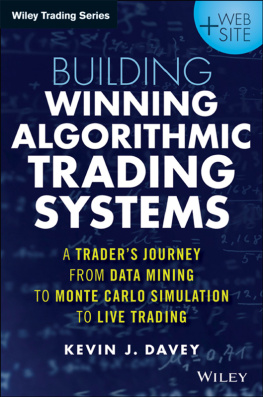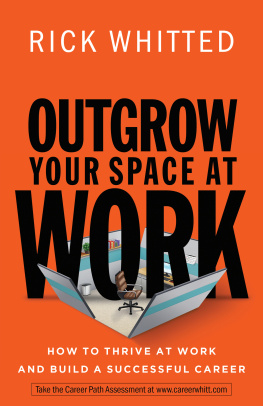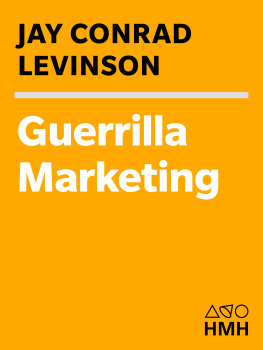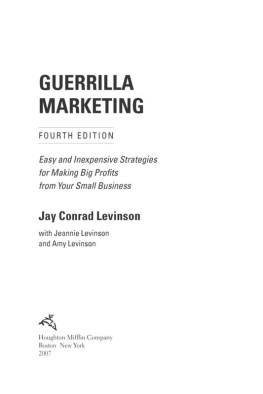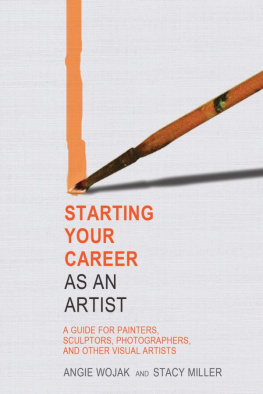GUERRILLA
MARKETING
for ARTISTS
How You Can Build a Bulletproof Art Career with 100 collectors
Barney Davey
Bold Star Communications
SCOTTSDALE, AZ
Copyright 2013 by Barney Davey
All rights reserved. No part of this publication may be reproduced, distributed or transmitted in any form or by any means, including photocopying, recording, or other electronic or mechanical methods, without the prior written permission of the publisher, except in the case of brief quotations embodied in critical reviews and certain other noncommercial uses permitted by copyright law. For permission requests, write to the publisher, addressed Attention: Permissions Coordinator, at the address below.
Barney Davey / Bold Star Communications
PO Box 25386
Scottsdale, AZ 85255
www.barneydavey.com
Ordering Information:
Quantity sales. Special discounts are available on quantity purchases by corporations, associations, and others. For details, contact the Special Sales Department at the address above.
Guerrilla Marketing for Artists / Barney Davey 1st ed.
All rights reserved.
ISBN-13:978-1484048757
ISBN-10: 148404875X
Contents
To Mary
Marketing is not an event, but a process It has a beginning, a middle, but never an end, for it is a process. You improve it, perfect it, change it, even pause it. But you never stop it completely.
JAY CONRAD LEVINSON
Foreword
The idea for this book originated from my workshops on art marketing for visual artists and photographers. As the past few years of a struggling economy have taken their toll on artists businesses, it became apparent artists needed to do things differently if they were going to have a thriving, rewarding career.
I believe guerrilla-marketing techniques are the best way for artists to seize control of their careers. What worked in the past does not work as well now. At the same time, artists have more and better tools than ever to help them sell directly to their customers, and in a happy coincidence, collectors are more motivated to buy directly from them.
This is the second book to come from an art-marketing workshop. In 2005, I wrote How to Profit from the Art Print Market . I am proud to announce the second edition remains a bestseller on the Amazon.com Business of Art and Prints categories more than eight years later. That book came from my first art-marketing workshop, which I did for the Sedona Arts Center. (I owe a shout out and nod to Vince Fazio, the Centers education director. Without his early encouragement, you might not be reading this book.) Afterwards, it quickly became apparent a book with the same information would help me reach many more artists than I ever could through doing workshops.
As soon as the book was published, I also began publishing an art business blog to help my readers stay current on changes in the art business with an emphasis on how art marketing was evolving. I picked a good time because between 2005, and now, the changes have been nothing less than seismic. Back then, a website was something to consider for advanced techie artists, but not essential for most artists. Galleries and publishers were still in control of much of the distribution of fine art. Since then, websites have become a necessity for artists, and other extraordinary developments have entered the market.
Those things include vastly improved consumer buying habits. We spend billions more for online purchases than we did in 2005. Print-on-demand technology in books and art prints has forever changed the landscape on how to get a book or print to market. Now, authors, musicians and artists can affordably publish their own work without having to carry inventory. Furthermore, they can use all sorts of sophisticated digital marketing tools to help them promote their work. The rise and phenomenon of blogging makes it easy for artists to build a loyal following of fans that they can talk to and market to directly. Website building has become easier with WordPress for the DIY crowd. Many superb specialized websites for artists are available for those who do not want to create their own website.
Websites and blogs began sweeping changes. Now social media, YouTube, email marketing, mobile marketing and more help artists reach new buyers. While all these different methods of building an art career and getting art sold have evolved, my businesss one-line mission statement has remained constant:
Inform and inspire artists to build thriving careers through continued success at the business of art.
My goal is to present my followers, or tribe, to use todays tech vernacular, with the most effective methods to market art, whether old school or cutting edge. To communicate my ideas and findings, I use my books, blogs, newsletters, social media posts, and workshops. This book is in some ways the culmination of all those things. What I want for artists who read it is to come away with a guerrilla marketing plan they can follow to help them build their own tribe. I contend if visual artists can get 100 or more collectors who directly buy from him; it will solidify their art career. That loyal base will help him achieve his art career goals.
Visual artists are no different from other small business operators. They need affordable ways to find customers and drive sales. This is where marketing comes into the art career. Without effective use of it, there will be no sales and no successful art career. In the past, some artists could sell to galleries or publishers and then use their marketing muscle to advance their career. While that might be possible in some rare cases these days, the truth is most visual artists need to be self-reliant and carry their own water when it comes to getting their art to market.
Unless the artist is lucky enough to have deep financial resources, the odds are that time is more abundant than money. This book is for those artists who realize they must take control of their future by creating their own distribution channels and selling directly whenever possible. I chose Guerrilla Marketing for Artists for the title because it aptly describes the situation of most artists. That is, they need affordable innovative marketing strategies where they can invest their time, energy, and creativity without a backbreaking budget. Guerrilla marketing includes the belief that building a core of 100 collectors is best served by maintaining a base of existing collectors while consistently marketing to acquire new ones. I think blending an appropriate mix of traditional marketing methods, including direct mail, publicity, press releases, networking, referrals and advertising with digital tools such as websites, blogs, email marketing and social media is how visual artists can create an art career with them in control.
In the past, I have written about creative borrowing, and as such would be remiss if I failed to give credit to two men who have helped shape my marketing ideas. They are Jay Conrad Levinson and Perry Marshall. Levinson wrote his bestselling original Guerrilla Marketing Handbook in 1984 and has had sales of more than 21 million copies since then. He also has written or co-written dozens of other bestselling books on guerrilla marketing topics for various specialized situations and businesses. Perry Marshall is the author of The Ultimate Guide to Google Adwords . He is a renowned internet-marketing guru. His Guerrilla Marketing for Hi-Tech Sales People CD is a powerhouse of practical information and has been listened to by tens of thousands of his tribe. This books title is in homage to Marshalls story of how he decided to use guerrilla marketing when naming his CD. In addition, to Levinsons enormous influence that has shown millions of small businesses how to level the playing field by using his perceptive marketing advice.
Next page

